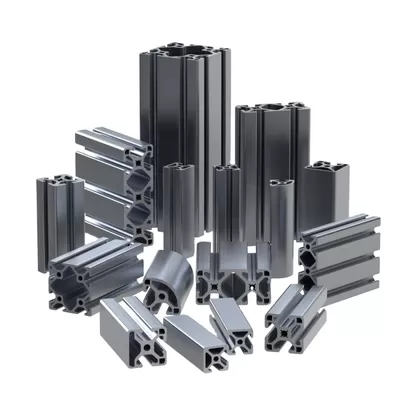Extruded aluminum profiles have emerged as a cornerstone of modern industry, offering a unique blend of versatility, durability, and cost-effectiveness. The extrusion process allows for the creation of complex shapes with precise dimensions, making aluminum profiles suitable for a wide range of applications across various sectors.
Understanding the Extrusion Process
At the heart of extruded aluminum profiles lies the extrusion process itself, a methodical and precise technique that transforms solid cylindrical billets of aluminum into intricate profiles.
The process begins with the heating of the billet to a temperature where it becomes soft but not molten. The softened aluminum is then forced through a specially designed die, which imparts the desired shape and cross-sectional profile onto the aluminum. Once extruded, the aluminum is rapidly cooled, cut to the required length, and heat-treated to enhance its mechanical properties.
Versatility in Design
The hallmark of extruded aluminum profiles is their unparalleled versatility in design. The extrusion process allows for the creation of profiles with complex shapes and cross-sections, such as T-slot, I-beam, and angle profiles. This versatility enables aluminum profiles to be tailored to meet the specific needs of various industries, including construction, automotive, electronics, and consumer goods.
Lightweight Yet Durable
One of the most compelling advantages of extruded aluminum profiles is their exceptional strength-to-weight ratio. Despite being lightweight, aluminum profiles are remarkably durable, making them ideal for applications where strength and weight are critical factors. Additionally, aluminum profiles exhibit excellent corrosion resistance and thermal conductivity, further enhancing their suitability for outdoor and high-temperature applications.
Cost-Effectiveness and Sustainability
Aluminum is a cost-effective material owing to its abundance and recyclability. The extrusion process itself is energy-efficient and produces minimal waste, making aluminum profiles a sustainable choice for manufacturers. Furthermore, aluminum profiles can be easily recycled at the end of their lifecycle, minimizing their environmental impact and contributing to a circular economy.
Applications Across Industries
Extruded aluminum profiles find applications across a diverse range of industries, showcasing their adaptability and utility. In the construction industry, aluminum profiles are used for window and door frames, curtain walls, and structural components. In the automotive sector, aluminum profiles are employed in body panels, chassis components, and heat exchangers. In the electronics industry, aluminum profiles serve as heat sinks, enclosures, and mounting brackets. In machinery, aluminum profiles are utilized for frames, conveyors, and guarding.
Customization and Fabrication Options
Extruded aluminum profiles offer a myriad of customization and fabrication options, allowing for tailored solutions to meet specific requirements. Profiles can be easily cut to length, machined, drilled, and finished with coatings or anodizing to enhance their appearance and performance. This flexibility in customization enables the creation of innovative and bespoke solutions for a wide range of applications.
Among the key players in the extruded aluminum profiles industry, Yonglong stands out as a leading supplier known for its commitment to quality and innovation. With a diverse range of profiles designed to meet the stringent requirements of modern industries, Yonglong has earned a reputation for excellence and reliability.
The Future of Extruded Aluminum Profiles
As technology continues to advance, the future of extruded aluminum profiles looks increasingly promising. Ongoing research and development efforts are focused on further enhancing the properties and capabilities of aluminum profiles, opening up new avenues for innovation and application across industries. Extruded aluminum profiles are poised to play a pivotal role in shaping the future of manufacturing and design, offering sustainable, cost-effective, and versatile solutions for the challenges of tomorrow.
Conclusion
In short, extruded aluminum profiles represent a remarkable fusion of innovation, sustainability, and versatility. Their unique properties and customization options make them an indispensable choice for manufacturers seeking to push the boundaries of design and functionality. As industries evolve and demands change, extruded aluminum profiles are set to remain at the forefront of innovation, driving progress and shaping the world around us.
